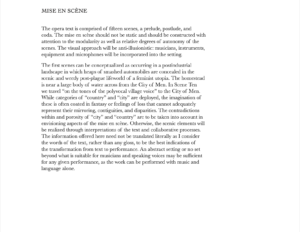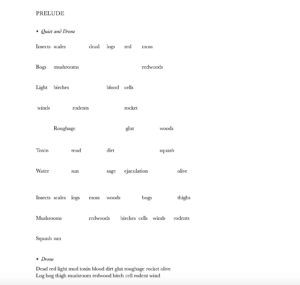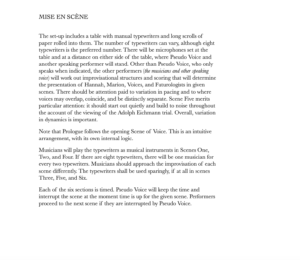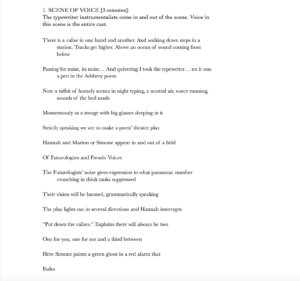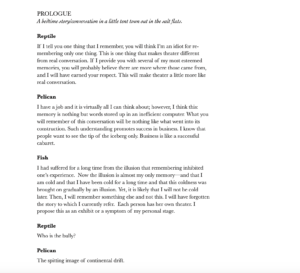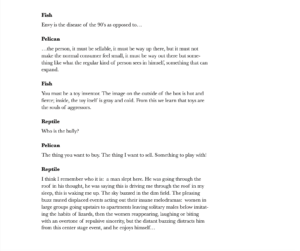A Voice to Perform: One Opera / Two Plays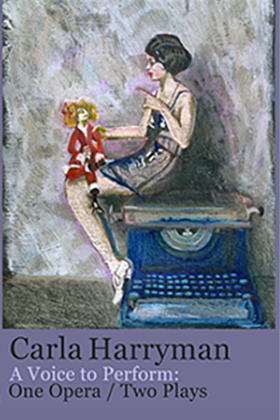
A Voice to Perform is:
HANNAH CUT IN: Assembled in tine-bound segments, each derived from the idea of interruption in the writings of Hannah Arendt, this play was created for a Poets Theater event at the University Art Museum, Berkeley, 2007.
MEMORY PLAY: A two-act, multifaceted conceptualization of memory-as-performance proffered by personified creature and instructions, a child, and a Miltonic Humiliator Toy.
GARDNER OF STARS, AN OPERA: A duo, a trio, a quarte, an ensemble, this work adapts Harryman’s experimental novel, Gardener of Stars “paradise and wastelands of utopian desire.”
“Harryman’s poets’ theater emphasizes embodied identities at the same time that it deconstructs them. These identities are not incidental, and they are not nonspecific; rather, they are fluid.” – Heidi Bean, Acts of Poetry
Live performance and writing exist in proximity for me, but they are not the same thing. I am interested in the ways text and performance make contact within ensemble and rehearsal situations.
—“Reflections on the Incomplete Project of Poet’s Theater”1
Performance and writing
The transposition of the text to performance is an occasion for multi- perspectival interpretation rather than faithful expression. Yet, text and performance remain connected as mutual explorations of performance and language. My thinking is influenced by structured improvisation in music, with its time-based compositional approaches to making performance and its simultaneous interest in constraint or limit.
The essay I quote from above also makes note of the link between composi- tion of a text and the construction of a work for performance, as the lan- guage used to describe this fuses tactics of written composition with those of performance:
The rehearsal will result in the rudiments of a collectively arrived at language for performance. Undoubtedly dynamics of repetition, change, interaction, moving forward, cutting, composing, looking backward or around and pausing will also serve as aspects of the foundational vocabulary.2
Performers bring to the performance situation their particular bodies, personalities, cultures, and skill sets, as well as their own attitudes toward experimentation beyond what is practiced and familiar: these shall inform the interpretive event within an open-ended collaborative setup. Together the written text and the performance process shape the performance as a distinct compositional object.
This performance-object is co-constructed by subjects who come together to make the provisional theater: it is provisional because the text will always be read and thus interpreted differently from one performance situation to the next. There will be a community of interpreters, but the community changes based on the literal occasion of the performance. Performers will experience the discursive text diversely and bring divergent interpretive and perfor- mance values to it. Consensus is not assumed, while mutual engagement is a tool for shaping the work. The autonomy of the performers will be mediated through processes of decision making and collective dynamics that create counterpoint and polyvocality. This can involve physical gesture as well as sonic and vocal expression.
There is always a limit to what occurs or will occur: decisions are made. The piece may or may not involve a director, but in any case, the work will favor the construction of spaces through which the reader/audience makes mean- ing. As Heidi Bean states, this is “not a theater of otherness but a theater of others.”3
The realization of a performance is dependent on people, material circum- stances, and economic limitations, the chosen approaches to the work at particular moments, and the challenges posed by the text. With respect to the performances of Memory Play I have been directly involved in, I have found that its successful renditions occur through lengthy, saturated rehearsal periods or, contrastively, through the presentation of lightly rehearsed read- ings that require no more than the plain voices of poets reading aloud for pleasure. If a piece foregrounds the interplay between improvised music and language, several practice sessions may be what is necessary, as would be the case with Hannah Cut In; or a work may be elaborately open and unfold over years with different performers coming in and out of the piece, interrogating its possibilities from different angles, as has occurred in the development of Gardener of Stars, an Opera.
About the opera and two plays
Each of the three works for performance in this collection are quite distinct with respect to the situation of its composition, its explored themes, and structure. One is a poetic opera adapted from a novelistic vision of “paradise and wastelands of utopian desire”; it has been performed and expanded in increments over the last five years. Another, completed for a Poets Theater event at the University Art Museum, Berkeley, in 2017, is assembled in time- based segments, each derived from the idea of interruption in the writings of Hannah Arendt. The third, written in the 1990s, is a two-act, multi-faceted conceptualization of memory-as-performance proffered by personified creatures and instructions, a child, and a Miltonic Humiliator toy.
1. In The Grand Piano: An Experiment in Collective Autobiography, 1974-1980, part 7 (Detroit: Mode A/This Press, 2008), 41.
2. Ibid., 39.
3. Heidi R. Bean, “Carla Harryman’s Non/Representation and the Ethics of Dispersive Performance.” Postmodern Culture 20, no. 1 (September 2009). Online.

